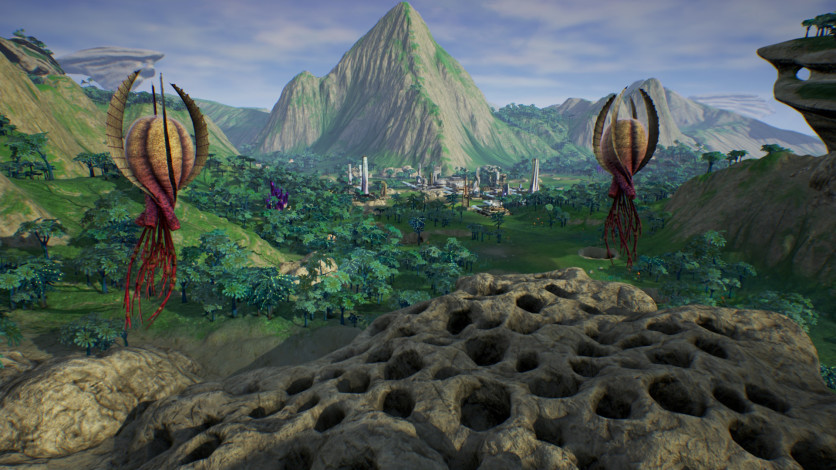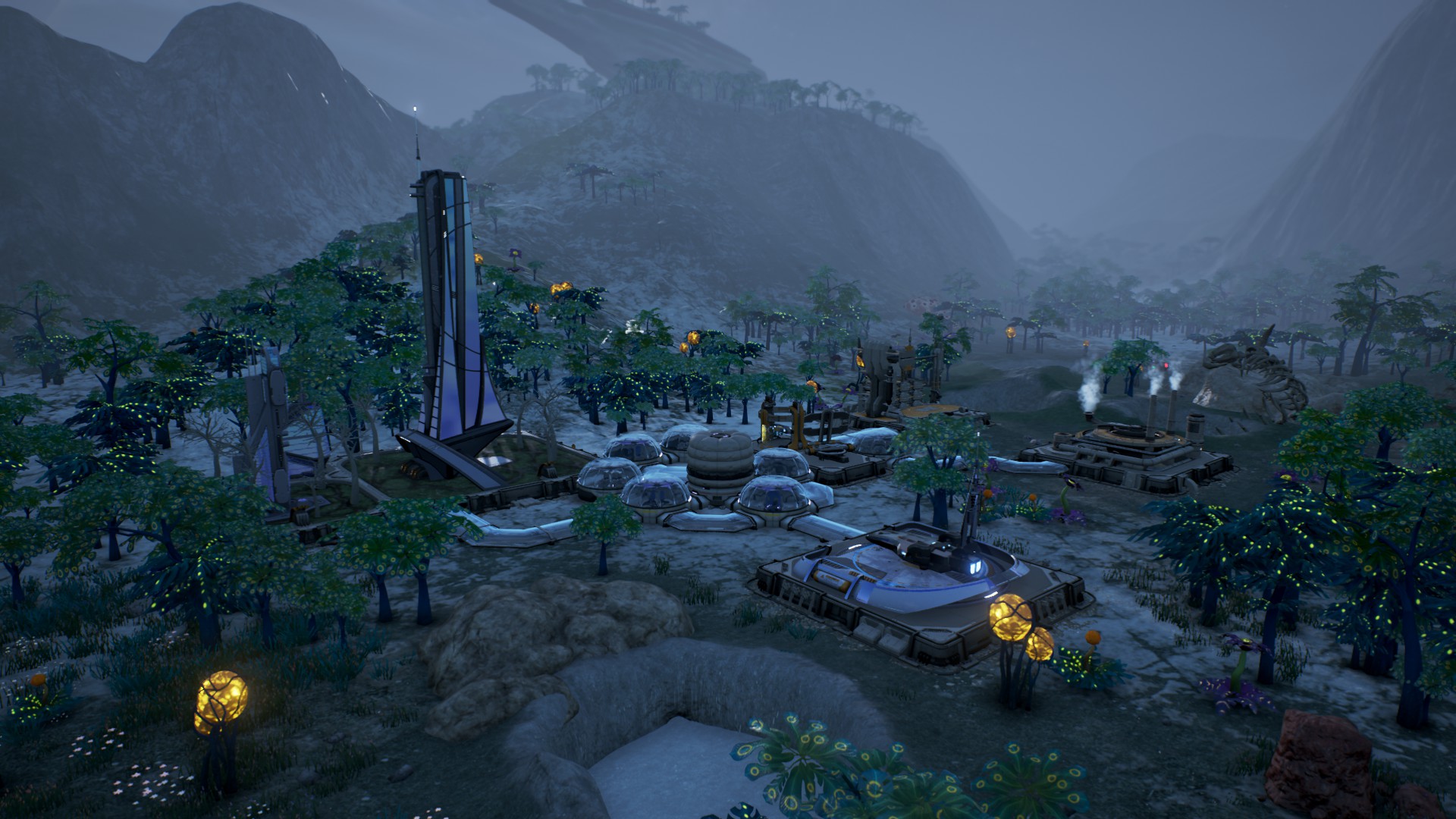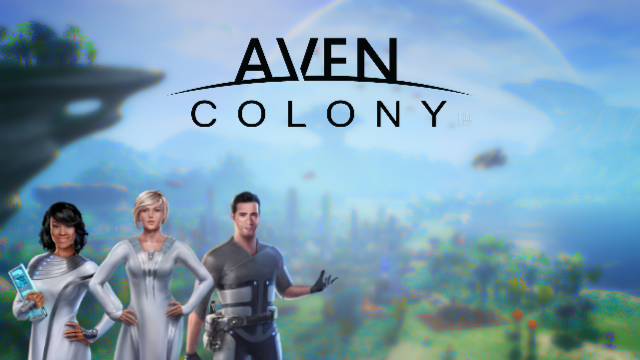After playing Mothership Entertainment’s Aven Colony for 20 plus hours, building and failing in multiple modes and land types, I feel confident saying that Aven Colony could pass as a Triple-A title.
While playing Aven I was quickly reminded that my primary experience in the genre of city builders comes from games like Civilization where your play style can be far more varied than in Aven. In this game, it is more important to remember classic city builders like Sim City that fit Aven more accurately.
Disclaimer: This preview covers an in-development build of the game and does not represent a finished or complete product.

Single-Player Campaign
The main story of Aven Colony places players in the role of the colonies’ governor who’s looking to rise up through the ranks. To do this, you must successfully colonize different regions of the alien world, Aven Prime. Taking place in the future, the Earth is only briefly mentioned as belonging in the history books.
In a varying amount of solaces, or seasons, the player faces referendum votes that reveal colonists’ complaints. These complaints usually relate to citizens’ commute to work but can also cover a breadth of other topics. You must address these complaints in order to stay popular because falling below 50% popularity will cause you to lose the game, which is 100% how elected offices work.
The campaign plays out over the course of a series of missions. Through each mission, players face increasingly difficult climates and varying circumstances that they must adapt to. This differs from more classic city builders, giving Aven a fun option for those who like a storyline alongside their building objectives. Before playing a mission, players can choose the difficulty setting. But be warned: anything above the normal setting might as well be on hard.
Even on easy, the missions put the player in a tight spot both in the way that you must use your resources and through the way that you must acquire them. Difficulty settings range from cakewalk to insane. These extremes could be narrowed down a bit more due to the fact that the difficulty scale skews to noticeable differences on insane rather than easier difficulties. Combining this with the referendums can make the game brutal at times, particularly on higher difficulties where my games became far shorter.
Where Aven does allow for players to expand and capitalize on resources, it also comes with punishing effects. These come in the form of seasonal challenges to agriculture, winning referendums to stay in power, and attacking alien life forms. These challenges are usually easily circumvented once you know to prepare for them, but that mastery is only really obtained through experience as it can be hard to actually evolve your strategy on the go in such a way. Ultimately, these challenges just become nuisances thanks to the fact that they appear more often the larger your colony grows.
Sandbox Gameplay & Control Features

Playing through the sandbox mode felt like a more casual/less hardcore play option, which should appeal to more players. In sandbox mode, players can choose far more options than in single-player while still being given goals to fulfill. This ended up making the sandbox mode feel like a longer campaign mission in a good way. Sandbox’s freedom also gives you more leeway to test out more difficult settings and environments without necessarily having the same penalties inherent to the campaign.
While playing in any mode players are given the option to address possible colony management issues through Aven’s overlay system. By simply selecting the aspect you want to manage such as air quality or safety and security, you get an overlay map on top of your buildings. Each comes with a color coordinated bar that shows how well or poorly you are doing in that aspect per area. This comes in handy with making sure colonists are more spaced out and not overcrowded in certain areas.
City controls also give you another level of control over your colony. These are only unlocked as your colony grows, with each feature only unlocking once a minimum number of colonists have been attained. While some seem helpful, such as rationing to maintain colonists needs, others are outright punishing and hit with morale costs for each, such as immigration bans and martial law to stop protesters. While these can be interesting to test your less benevolent side of governance, they also felt a little too punishing in some situations. (How you fundamentally undermine democracy and maintain an approval rating above 50% is above me.) Thankfully, they are often only temporary fixes that can be switched off after a crisis is averted.
The future might need more improvements

Sadly, some of the more unique systems — aliens and weather — felt like they were poorly handled. This is seen in everything from the lackluster alien life forms, like the plague spores pictured above, to the overly broad effects of seasons.
The aforementioned spores float mindlessly towards your colony, seeking to infect one of your buildings. Beyond the element of surprise, they are usually easy to stop since they are entirely absent minded which means that they never really force you to dynamically react to their presence. For all the alien life that could have lived on the planet, these seem like a waste to fight.
Weather patterns aren’t often what we look for in a game, so it was refreshing to have them become a strategic part of the game. Sadly, however, the effects of weather often didn’t make sense. For instance, the winter solace has the same effects across all climate zones. Why would an arid desert where farming is already sparse take an extra hit by having extreme winters as well?
While these features do have some shortcomings, they also allow Aven to provide a variety of scenarios that just aren’t seen in most other city builders. For instance, when weather like lightning threatens your buildings, features like creating batteries and weather defenses are available. Small features such as that which require more careful colony planning definitely add something new to the genre rather than the classic damaged building you just pay to repair like in other games.
These scenarios come into play far more while playing the single-player campaign. They also help keep players from settling into the normal city builder tempo. While many city builders run become monotonous, Aven shows the genre can be far more dynamic with multiple moving pieces that challenge players.
Appreciate a full indie city builder

It will be exciting to see where Aven Colony goes after launch. As more improvements are added, Mothership Entertainment LLC should rest assured they have more than the foundations of an excellent city builder that will have longevity. While Aven can become difficult and repetitive, its number of unique scenarios can really help it shine. Alongside features like the overlay system, city controls, and the campaign, this is a game worth returning to.
Right now players can pre-order Aven on Steam and save 10% until release on July 25, 2017.







Published: Jul 11, 2017 01:54 am